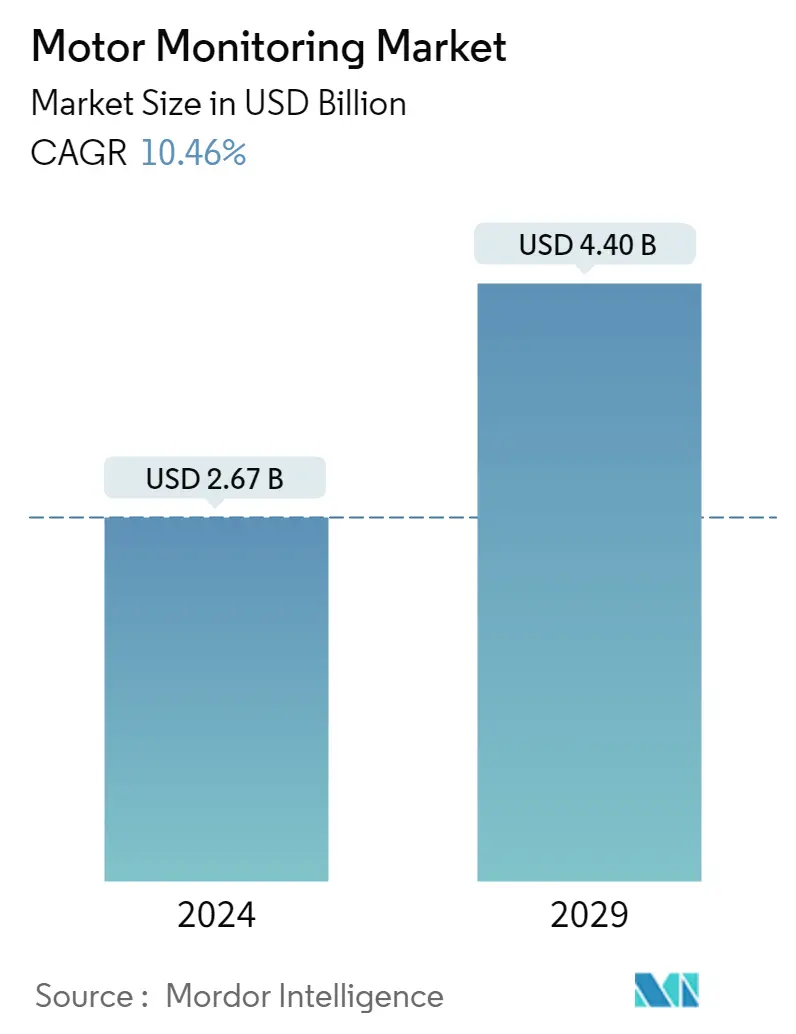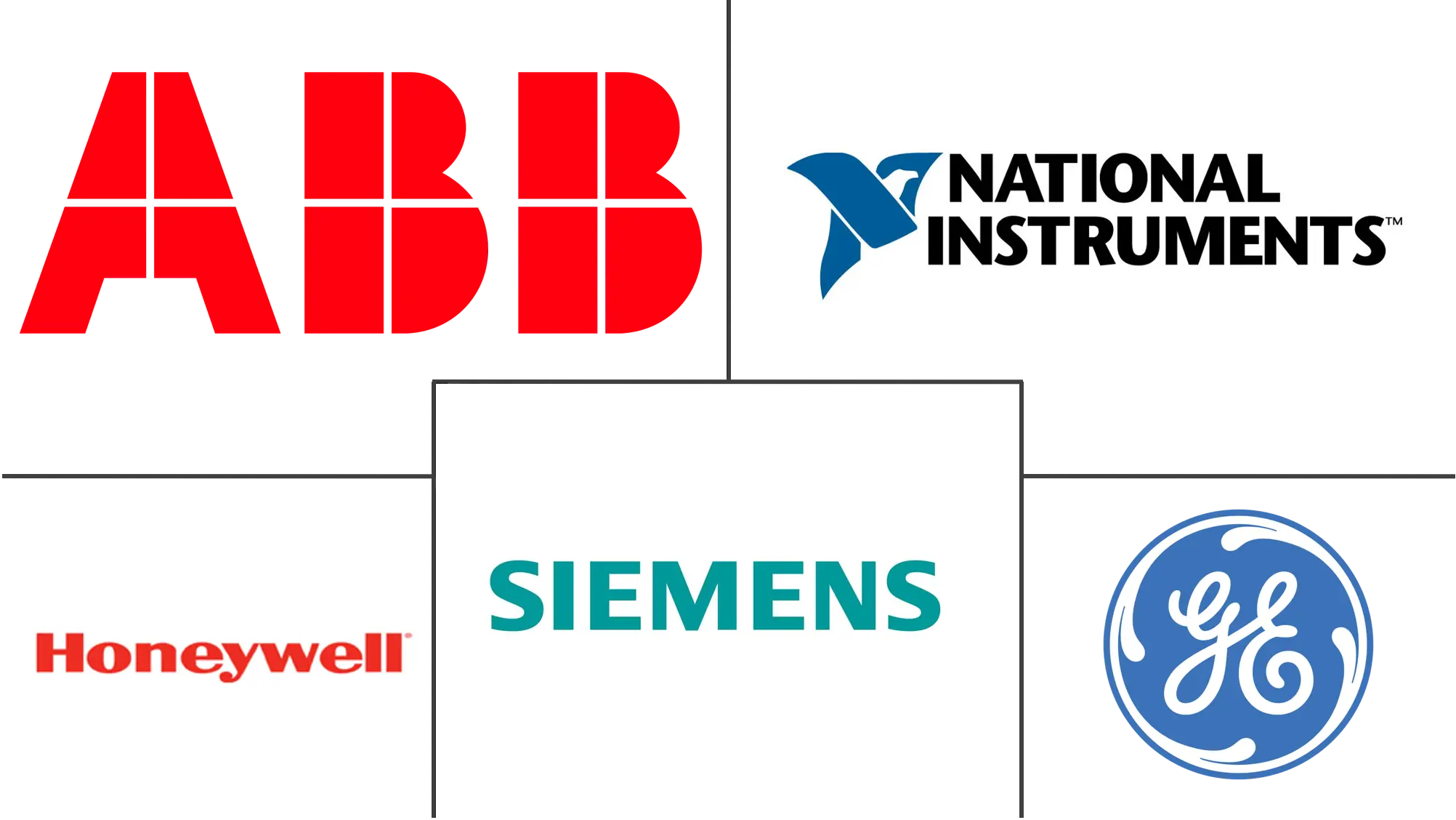Market Size of Motor Monitoring Industry

| Study Period | 2019 - 2029 |
| Market Size (2024) | USD 2.67 Billion |
| Market Size (2029) | USD 4.40 Billion |
| CAGR (2024 - 2029) | 10.46 % |
| Fastest Growing Market | Asia Pacific |
| Largest Market | North America |
| Market Concentration | Low |
Major Players
*Disclaimer: Major Players sorted in no particular order |
Motor Monitoring Market Analysis
The Motor Monitoring Market size is estimated at USD 2.67 billion in 2024, and is expected to reach USD 4.40 billion by 2029, growing at a CAGR of 10.46% during the forecast period (2024-2029).
All rotating machines experience vibration. Motors have different faults that vibration screening can identify. The adoption of condition monitoring with wireless IoT sensors and cloud-based software empowers industry professionals to get ahead of equipment problems and avoid downtime by accessing current, vibration, and temperature data from anywhere in a plant at any given time. This follows an ongoing trend driving the growth of the market.
- Growing awareness of predictive maintenance and augmenting it with analytics drive the market. The importance of electric motor monitoring is connected to the damages deriving from the failure of even a single motor. It has been estimated that for each downtime hour, the cost of the missed production is around EUR 1000 in the pasta production sector. Further implementing predictive maintenance and training the internal maintenance staff to make them autonomous in the shortest possible time is one of the low-cost solutions.
- Rule-based predictive maintenance relies on sensors to continuously collect data about assets and sends alerts according to predefined rules, including when a specified threshold has been reached. With rule-based analytics, product teams work alongside engineering and customer service departments to establish causes or contributing factors to their motor failing. Hence these industrial IoT technologies drive the market.
- The growing adoption of wireless systems for motor monitoring drives the market. Electrical motors and drives consume about 45% of the power generation. However, if the electrical machines are not maintained properly, it consumes about 5% to 10 % of excess power, which affects productivity and revenue. Wireless monitoring of the motor is capable of capturing the machine parameters more accurately with automatic detection of abnormal conditions and reporting to the server within a few microseconds. The advantage of wireless technology is that it is very reliable and operates even at very slow network speeds,and handles multiple devices at once. The designed system is easy to install and scale up to large industrial setups as it does not involve a complex mechanism and uses a lightweight MQTT protocol.
- However, lacking customization with the high initial investment restraints the growth of the market. Due to the integration of new technologies, industrial systems are becoming more complex. At the same time, it makes maintenance and monitoring activities more expensive and complicated to get reliable data on time. The more sensors are wareintegrated into the system, the more data will be generated that should be handled. But processing this growing number of data through database technologies will be challenging. This problem is directly related to the concept of Big Data. There has also been an impact of the Russia-Ukraine war on the overall packaging ecosystem.
- However, the COVID-19 pandemic affected production in manufacturing plants such as the automotive, mining sector, etc. But the digital transformation is offering significant features to manufacturers, such as real-time visibility into the equipment which have deployed the cloud solution and provides them with the ability to analyze the condition of their motor. Further software solutions equipped by the manufacturing plant can also be monitored by their central system.
- Moreover, COVID-19 forced quicker adoption of a new predictive maintenance service model on motor-driven systems as there is a restriction in traveling to perform asset health analysis. Various service providers performed an analysis through these critical portable monitoring devices, such as Fluke's 810 Vibration Tester or Megger's Baker EXP4000. Smart sensors are a readily available tool providing a remote view into client assets, which in turn eliminates the immediate need to travel to a facility. Remote monitoring and diagnosis will be a key acceptance and further help to drive the market in this situation.
Motor Monitoring Industry Segmentation
Motor monitoring, which has applications in a number of industry verticals, including oil & gas, power generation, aerospace & military, automotive, and others, is the collection, sorting, and analysis of streaming data using detectors, sensors, diagnostic software, and other tools.
The motor monitoring market is segmented into hardware and software, ensuring basic-level monitoring of motors in plants or systems through further deployment in the cloud or on-premise among the end-users such as oil & gas, energy & power, mining, etc. The motor monitoring market is segmented by offerings (hardware, software), Deployment (cloud, on-premise), end-user (automotive, oil & gas, energy & power, mining, food & beverage, chemicals, aerospace & defense), and geography.
The market sizes and forecasts are provided in terms of value (USD) for all the above segments.
| Offering | |
| Hardware | |
| Software |
| Deployment | |
| Cloud | |
| On-Premise |
| End-User | |
| Automotive | |
| Oil & Gas | |
| Energy & Power | |
| Mining | |
| Food & Beverage | |
| Chemicals | |
| Aerospace & Defense | |
| Other End-Users |
| Geography | ||||||
| ||||||
| ||||||
| ||||||
|
Motor Monitoring Market Size Summary
The motor monitoring market is poised for significant growth, driven by the increasing adoption of condition monitoring technologies such as wireless IoT sensors and cloud-based software. These advancements enable industry professionals to proactively address equipment issues and minimize downtime by providing real-time access to vibration and temperature data. The market is further propelled by the growing awareness of predictive maintenance, which helps prevent costly production losses due to motor failures. The integration of rule-based predictive maintenance systems, which utilize sensors to monitor asset conditions and trigger alerts, is also contributing to market expansion. Despite challenges such as high initial investment costs and the complexity of integrating new technologies, the market continues to thrive, particularly in sectors like oil and gas, where the financial and environmental stakes are high.
Regionally, Asia-Pacific is expected to witness substantial market growth, fueled by industrial expansion in countries like China and India. The emergence of Industry 4.0 and the increasing focus on digital transformation are further enhancing the demand for motor monitoring solutions in these regions. Key players in the market, including ABB Group and Siemens AG, are leveraging innovative solutions and predictive analytics to differentiate their offerings and capture market share. Recent product launches, such as OMRON's K7DD-PQ Series and Honeywell's Versatilis Transmitters, highlight the ongoing advancements in motor condition monitoring technologies. As the market continues to evolve, the role of IoT in online condition monitoring is expected to gain prominence, further driving market growth over the forecast period.
Motor Monitoring Market Size - Table of Contents
-
1. MARKET INSIGHTS
-
1.1 Market Overview
-
1.2 Industry Value Chain Analysis
-
1.3 Industry Attractiveness - Porter's Five Forces Analysis
-
1.3.1 Threat of New Entrants
-
1.3.2 Bargaining Power of Buyers/Consumers
-
1.3.3 Bargaining Power of Suppliers
-
1.3.4 Threat of Substitute Products
-
1.3.5 Intensity of Competitive Rivalry
-
-
1.4 Assessment of Impact of COVID-19 on the Industry
-
-
2. MARKET SEGMENTATION
-
2.1 Offering
-
2.1.1 Hardware
-
2.1.2 Software
-
-
2.2 Deployment
-
2.2.1 Cloud
-
2.2.2 On-Premise
-
-
2.3 End-User
-
2.3.1 Automotive
-
2.3.2 Oil & Gas
-
2.3.3 Energy & Power
-
2.3.4 Mining
-
2.3.5 Food & Beverage
-
2.3.6 Chemicals
-
2.3.7 Aerospace & Defense
-
2.3.8 Other End-Users
-
-
2.4 Geography
-
2.4.1 North America
-
2.4.1.1 United States
-
2.4.1.2 Canada
-
-
2.4.2 Europe
-
2.4.2.1 Germany
-
2.4.2.2 United Kingdom
-
2.4.2.3 France
-
2.4.2.4 Rest of Europe
-
-
2.4.3 Asia-Pacific
-
2.4.3.1 India
-
2.4.3.2 China
-
2.4.3.3 Japan
-
2.4.3.4 Rest of Asia-Pacific
-
-
2.4.4 Rest of the World
-
2.4.4.1 Latin America
-
2.4.4.2 Middle-East and Africa
-
-
-
Motor Monitoring Market Size FAQs
How big is the Motor Monitoring Market?
The Motor Monitoring Market size is expected to reach USD 2.67 billion in 2024 and grow at a CAGR of 10.46% to reach USD 4.40 billion by 2029.
What is the current Motor Monitoring Market size?
In 2024, the Motor Monitoring Market size is expected to reach USD 2.67 billion.

